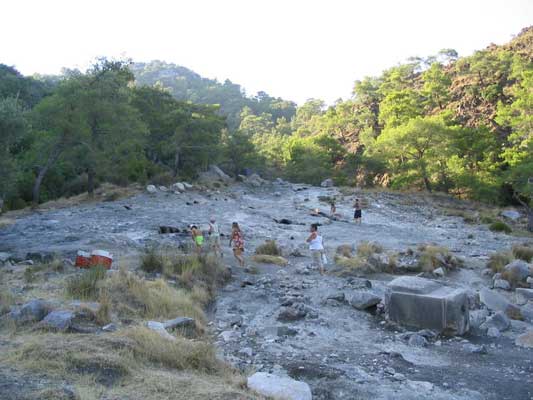.
Chimaera in antiquity, in addition to being the name of a monster, was the name of a volcanic site which was held , by euhemerizing geographers, to have inspired the myth.
Ctesias (as cited by Pliny the Elder and quoted by Photius) identified the Chimaera with an area of permanent gas vents which can still be found today by hikers on the Lycian Way in southwest Turkey. Called in Turkish Yanartas (flaming rock), it consists of some two dozen vents in the ground, grouped in two patches on the hillside above the Temple of Hephaistos about 3 km north of Çıralı, near ancient Olympos, in Lycia. The vents emit burning methane thought to be of metamorphic origin, which in ancient times sailors could navigate by, and which today is used to brew tea. (Strabo held the Chimaera to be a ravine on a different mountain in Lycia.)

Some say this geothermically active region was the inspiration for the myth
Strabo and Pliny are the only surviving ancient sources who would be expected to discuss a Lycian toponym, but the placename is also attested by Isidore of Seville and Servius, the commentator on the Aeneid. Isidore quotes writers on natural history (see below) that Mount Chimaera was on fire here, had lions and goats there, and was full of snakes over there. Servius goes so far as to arrange these with the lions on the peak of the mountain, pastures full of goats in the middle, and serpents all about the base, thus imitating Homer's description of the monster exactly.
The site was identified by Sir Francis Beaufort in 1811, and described by T.A.B.Spratt in his Travels in Lycia, Milyas, and the Cibyratis, in company with the late Rev. E. T. Daniell. (1847)

The fires of Chimera at night. (Source)
Testimonia
Fingunt et Chimaeram triformem bestiam; ore leono, postremis partibus draco, media caprea. Quam quidam Physiologi non animal, sed Ciliciae montem esse aiunt, quibusdam locis leones and capreas nutrientem, quibusdam ardentem, quibusdam plenum serpentibus. Hunc Bellorophontes habitabilem fecit, unde Chimaeram dicitur occidisse. Isidore of Seville, Etymologiae 11.3.36
- The Chimera is depicted as a three-formed beast; a lion in front, a python in its hinder parts, goatlike in the middle. Certain writers on natural history say it isn't an animal, but a mountain in Cilicia, which in some places feeds lions and goats, in some burns, in some is full of snakes. Bellerophon made this habitable, whence he is said to have "killed Chimaera".
- Isidore unetymologically connected Lycia and Cilicia, as below.
- Isidore unetymologically connected Lycia and Cilicia, as below.
- Lycia nuncupata quod ab oriente adjuncta Ciliciae sit. Nam habet ab ortû Ciliciam, ab occasû et meridie mare, a septentrione Cariam. Ibi est mons Chimaera, qui noctibus aestibus ignem exhalat: sicut in Siciliâ Aetna et Vesuvius in Campaniâ. Isidore of Seville, Etymologies 14,3,46.
- There [in Lycia] is Mount Chimaera, which breathes out fire on summer nights, like Etna in Sicily and Vesuvius in Campania.
- There [in Lycia] is Mount Chimaera, which breathes out fire on summer nights, like Etna in Sicily and Vesuvius in Campania.
- Pliny 2.105 Mayhoff
- Mount Chimaera (English)
- Mount Chimaera (English)
- Pliny 5.43
- Mount Chimaera (English}
- Mount Chimaera (English}
- Pliny 5.53
- Chimaera as a geographical reference point. (English)
- "Cape" is a gloss of the translator.
- "Cape" is a gloss of the translator.
- Perseus's English version of Pliny differs in chapter numbering; these become 2.110, 5.28, 5.35 resp.
- Chimaera as a geographical reference point. (English)
- Servius on Aeneid 6.288.
- "In fact, there is a Mount Chimaera..."
- "In fact, there is a Mount Chimaera..."
- Strabo 14.3.5,"a certain ravine, Chimaera, stretching up from the coast." (English)
- Near Adratchan, not far from the ruins of Olympus, a number of rounded serpentine hills rise among the limestone, and some of them bear up masses of that rock. At the junction of one of these masses of scaglia with the serpentine, is the Yanar, famous as the Chimæra of the ancients, rediscovered in modern times by Captain Beaufort. It is nothing more than a stream of inflammable gas issuing from a cavern, such as is seen in several places among the Appenines. The serpentine immediately around the flame is burnt and ashy, but this is only for a foot or two, the immediate neighborhood of the Yanar presenting the same aspect as it wore in the days of Seneca, who writes "Laeta itaque regio est et herbida, nil flammis adurentibus" Letters 79,3 Such is the Chimæra—
...flammis que armata chimæra*—
deprived of all its terrors. It is still, however, visited as a lion by both Greeks and Turks, who make use of its classic flames to cook kebobs for their dinners. [Footnote: *Virgil, Æ, vi. 288] Spratt, op. cit. (London, 1847) Vol. II, p.181-2
- In Lycia regio notissima est (Hephaestion incolae vocant), foratum pluribus locis solum, quod sine ullo nascentium damno ignis innoxius circumit. Laeta itaque regio est et herbida, nihil flammis adurentibus sed tantum vi remissa ac languida refulgentibus. Seneca Epistles 79, 3
See also
| Ancient Greece
Science, Technology , Medicine , Warfare, , Biographies , Life , Cities/Places/Maps , Arts , Literature , Philosophy ,Olympics, Mythology , History , Images Medieval Greece / Byzantine Empire Science, Technology, Arts, , Warfare , Literature, Biographies, Icons, History Modern Greece Cities, Islands, Regions, Fauna/Flora ,Biographies , History , Warfare, Science/Technology, Literature, Music , Arts , Film/Actors , Sport , Fashion --- |
Retrieved from "http://en.wikipedia.org/"
All text is available under the terms of the GNU Free Documentation License


